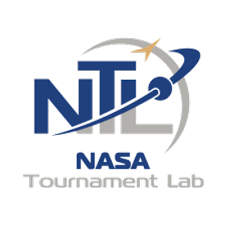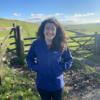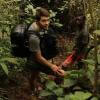Ten years ago, we couldn't have imagined how tools like machine learning, eDNA, and satellites would advance and transform conservation work. Now technology is advancing faster than ever, and as tools become smaller, lighter, and more affordable, it's vital to have a space where community members can discuss the next big thing, share ideas, compare tool options, and tell the story of their experiences - positive, negative, and anything in between - while using new technologies.
In 2021, the WILDLABS State of Conservation Tech report detailed what tools show the most promise according to community members, as well as what tools are currently seen as the most effective. And as new tools enter the field, we're excited to see how this data will change over time, and how this group grows over time as well.
Our State of Conservation Tech research also discusses something called the "Hype Cycle" - the pattern that occurs when a new technology bursts onto the scene, promises to be an exciting solution, encounters challenges as new users adopt the tool and put it into practice beyond just theory, and eventually settles into its most effective state as users acquire the right skills to use it to its actual potential. Machine learning, one of the most promising technologies, is currently in the middle of its own hype cycle, and we see community members working through their own hurdles to incorporate ML into their work effectively. Despite what you may think, this Hype Cycle can also be positive for tech development, as it means that users have big ideas for new tools, and with the right resources and skills, they can work toward bringing those ideas to life. And as our community members experiences the Hype Cycle for various tools at their own paces, we hope this group will also serve as a place to discuss that process and overcome hurdles together.
Ready to discover new possibilities? Join our Emerging Tech group now and get to know your forward-thinking conservation tech peers!
Header photo: Internet of Elephants
PhD student with research focused on using on-site DNA sequencing for rapid species identification. Interested in wildlife forensics, and conservation genomics.
- 0 Resources
- 0 Discussions
- 4 Groups
- @Gcharron
- | Mr.
Cofounder of Outreach Robotics, I have a master in mechanical engineering and I thrive on developing new technology for field scientists using remote controlled robots.
- 1 Resources
- 1 Discussions
- 4 Groups
- 1 Resources
- 5 Discussions
- 4 Groups
I am a forensic geneticist with a long term interest in developing and applying DNA markers to combat wildlife crime. Currently developing and validating STRs for raptors and rapid on-site species ID using the ONT MinION portable sequencer.
- 2 Resources
- 0 Discussions
- 5 Groups
- @garthpaine
- | He/Him
Arizona State University
Garth Paine (https://www.activatedspace.com/ ) is acoustic ecologist, composer, sound artist, and academic (ASU) based in USA/Australia. He is known for his pioneering work on species density metrics from ambient recordings and his anti-poaching efforts
- 1 Resources
- 0 Discussions
- 5 Groups
Early-career movement ecologist currently working with an interdisciplinary team to develop and deploy animal-borne tracking devices with the interest of monitoring and studying the fine-scale behaviors of large carnivores, particularly in the context of human wildlife conflict
- 0 Resources
- 2 Discussions
- 10 Groups
Cave biologist and conservationist
- 0 Resources
- 0 Discussions
- 4 Groups
- @Gody
- | He
Godfrey Nyangaresi, a dedicated Protection Manager with 12+ years of wildlife conservation experience. Skilled in technologies, administration, and law enforcement, he leads protection efforts at STEP, ensuring the sustainable conservation of elephants in southern Tanzania.
- 0 Resources
- 1 Discussions
- 17 Groups
PhD Candidate at University College London. Research and develop wireless sensor networks for biodiversity monitoring. Currently working on a software package for AI bioacoustics classifiers on edge device.
- 0 Resources
- 2 Discussions
- 8 Groups
Director of Spatial Planning and Innovation Nature Conservancy of Canada
- 0 Resources
- 0 Discussions
- 12 Groups
Firmware/Electronics Engineer with 10+ years of experience building telemetry devices for wildlife conservation. I'm an avid birdwatcher and enjoy wildlife photography. CTO and Senior Engineer at Cellular Tracking Technologies.
- 0 Resources
- 0 Discussions
- 7 Groups
- @kricherds
- | she/her
Technology advisor for social change
- 0 Resources
- 0 Discussions
- 13 Groups
In a recent publication we tested Underwater Passive Acoustic Monitoring (UPAM) as a feasible non-invasive technique to study the calling behavior of therathened aquatic Andean frogs under natural conditions in the...
6 April 2024
After a long application review and finalisation process, we are thrilled to finally announce the winners of the WILDLABS Awards 2024!
26 March 2024
Article
You’re invited to the WILDLABS Variety Hour, a monthly event that connects you to conservation tech's most exciting projects, research, and ideas. We can't wait to bring you a whole new season of speakers and...
22 March 2024
Catch up on the conservation tech discussions and events that happened during World Wildlife Day 2024!
7 March 2024
WILDLABS was honoured to represent the global conservation technology sector on the world stage, joining the World Wildlife Day celebrations at the UN. As an invited speaker, Stephanie O'Donnell used her talk to share...
7 March 2024
We invite applications for the third Computer Vision for Ecology (CV4E) workshop, a three-week hands-on intensive course in CV targeted at graduate students, postdocs, early faculty, and junior researchers in Ecology...
12 February 2024
A portable nanopore DNA sequencer has been used to determine the species of origin of bushmeat intercepted at Brussels Airport during a day of baggage searches.
6 February 2024
In this paper, we report new polynomial type architectures, that we show improve shape awareness in image recognition applications, including in conditions such as blur and fog, making things potentially useful for...
11 January 2024
Article
A game-changing new tool is helping conservationists working with critically endangered cliff plants
9 January 2024
Funding
With $60,000, $30,000, and $10,000 grants available for 14 outstanding projects, the support of engineering and technology talent from Arm (the leading semiconductor design company), and access to the world’s biggest...
1 December 2023
Funding
A 6-month tailored accelerator for underrepresented founders in Europe to scale their impact startup.
28 November 2023
The Department of Applied Ocean Physics and Engineering (AOPE) at the Woods Hole Oceanographic Institution (WHOI) seek to hire 1-2 scientists at any of the Assistant/Associate/Senior Scientist levels to develop research...
27 November 2023
April 2024
event
event
November 2023
event
| Description | Activity | Replies | Groups | Updated |
|---|---|---|---|---|
| Already an update from @hikinghack: |
|
Autonomous Camera Traps for Insects, AI for Conservation, Emerging Tech, Open Source Solutions | 47 seconds ago | |
| 'Most importantly, we have to make it play a MIDI version of the DoctorWho theme song when you arm the device. That has to be the #1 feature if you ask me!' Seconded! |
+9
|
Acoustics, Biologging, Emerging Tech, Open Source Solutions, Sensors | 1 day 19 hours ago | |
| Hi Matthew,Thanks for your advice, this is really helpful!I'm planning to use it in a seagrass meadow survey for a series of ~20 drops/sites to around 30 m, recording for around... |
|
Acoustics, AI for Conservation, Data management and processing tools, Emerging Tech, Sustainable Fishing Challenges | 2 days 22 hours ago | |
| This is so cool @Mauricio_Akmentins - congrats and look forward to seeing your project evolve! |
|
Acoustics, Biologging, Climate Change, Conservation Tech Training and Education, Data management and processing tools, Emerging Tech, Open Source Solutions, Protected Area Management Tools, Sensors, Software and Mobile Apps | 1 week 3 days ago | |
| Hi @Alasdair Great to hear from you! Thanks for the comment and for those very useful links (very interesting). And for letting @Rob_Appleby know. I can't wait to hear... |
|
Emerging Tech, Camera Traps, Conservation Tech Training and Education | 2 weeks 4 days ago | |
| Hello everyone, I'm interested in gathering insights on how the behavior of different species impacts the development and efficacy of... |
|
Biologging, Acoustics, Camera Traps, eDNA & Genomics, Emerging Tech, Marine Conservation | 3 weeks 5 days ago | |
| Hi @timbirdweather I've now got them up and running and winding how I can provide feedback on species ID to improve the accuracy over time. It would be really powerful to have a... |
|
Acoustics, AI for Conservation, Citizen Science, Emerging Tech | 1 month ago | |
| Thank you for the help! |
|
Biologging, Emerging Tech | 2 months ago | |
| Hi David, would love to collaborate with you on this topic. A few years ago Dr. Nick van Doormaal did his PhD on snaring with us and we ran a number of experiments on the... |
+4
|
AI for Conservation, Drones, Emerging Tech, Human-Wildlife Conflict, Wildlife Crime | 2 months ago | |
| You can already achieve both of them with your prompt. Or, if you're not using ChatGPT specifically but another LLM that you can fine tune, you can use RAG or fine tuning to... |
+35
|
AI for Conservation, Emerging Tech | 2 months ago | |
| Hi Danilo. you seem very passionate about this initiative which is a good start.It is an interesting coincidence that I am starting another project for the coral reefs in the... |
|
Acoustics, AI for Conservation, Biologging, Camera Traps, Citizen Science, Climate Change, Community Base, Connectivity, Drones, Emerging Tech, Human-Wildlife Conflict, Open Source Solutions, Sensors, Software and Mobile Apps, Wildlife Crime | 2 months 2 weeks ago | |
| Hi!I would take a look at Although developed for camera trap imagery, it is by no means restricted to such.Cheers,Lars |
|
Camera Traps, Community Base, Data management and processing tools, Drones, Emerging Tech, Remote Sensing & GIS, Software and Mobile Apps | 2 months 3 weeks ago |
Opportunity: networking, funding and more...
15 November 2022 4:35pm
2 December 2022 3:08pm
Super interesting! I registered immediately.
Perhaps good to know is that if one registers, it is not only to apply for the upcoming symposium but also for future ones. So even if the coming symposium is not a perfect fit, one may register anyways.
16 December 2022 3:06pm
Thanks Alice, it does!
Help - Innovative ways to track elephant movement
28 October 2022 4:50pm
4 November 2022 5:24pm
Why would you want to avoid alerting the rangers ?
You don't need high tech for this; elephants leave very obvious tracks and sign.
7 November 2022 12:52am
Hi Tyler,
Would like to introduce you to Ceres Tags products
- Ceres Tags products come in boxes of 5, 10 and 24.
- There are some software partners such as Earthranger, Mapipedia and possibly CiboLabs that would be able to assist you with your mapping vegetation requirements
- Ceres Tag does not require any towers, base stations and infrastructure. This allows you to see any movements from the heard outside of their normal herd (boundary alerts), and you will not be disturbing any of the flora and fauna with infrastructure set up.
- For the timing you are looking at, Ceres Wild pings directly to satellite 24 times a day. For Ceres Trace and Ceres Ranch there are 4 within 24 hours. Taking into consideration, when you set up alert areas, you will get them directly to your phone/laptop via your software of choice
- Ceres Ranch is a reusable tag that has just been launched. Use it on this project, remove the tag and then use the tag on your next project
- The software you choose will assist with the history of your animal movements. Ceres Tag is integrated with 11 software partners and in-development with 18 software partners https://cerestag.com/pages/software-partners
- Understanding it is a short-term project, you would be able to use Ceres Tags products without the additional expense of setting up and removing infrastructure- towers, gateways
- With Ceres Tag, you are purchasing the box of tags and picking a suitable software to deliver the information you require. On average, a box of 10 Ceres Trace Tags, is the same as 1 LoRaWAN tower.
14 December 2022 10:49am
I just came across this interesting paper in which seismic monotoring of animals like elephants was mentioned.
This is the study refered to:
Cheers,
Lars
Workshop Invite: Building Partnerships between Conservation Tech and the UK Space Sector
22 September 2022 3:50pm
5 December 2022 3:10pm
Hi Steph,
If it's not too late, I'm very interested in this workshop.
Best,
V
6 December 2022 5:52pm
Hey Vance! We hosted the workshop a few weeks ago, but we're doing follow up calls and future meetings. I'll loop you into the next call!
Steph
12 December 2022 12:03am
Hi Steph. Would be interested also.
PhD - Sensory ecology of vespine wasps
8 December 2022 12:47pm
Full-stack developer - Consultancy
6 December 2022 11:01am
New: Satellites for Biodiversity Award
5 December 2022 2:08pm
The force is strong with space lasers helping researchers map the Amazon in 3D
2 December 2022 1:16am
The International Space Station's GEDI instrument uses lasers to gather data on deforestation and impacts on atmospheric concentrations of carbon dioxide to highlight key areas to conserve.
Picking up signal of GPS tag
10 November 2022 11:29am
16 November 2022 10:54am
Thanks Carly! I've been in awe of what Wildlife Drones is doing, but as you say my work at the moment is focussed on existing GPS units rather than telemetry for tracking. I'll still reach out & ask though. Thanks for your help! :)
16 November 2022 10:55am
Hi Kim! Thanks for sharing, this is really interesting! I'll check out the website & see what I can find out about the mechanics of the device. Thanks again!
21 November 2022 5:25pm
Hey Sol,
The only way for you to collect information from a GPS tag attached to a FAD is if that tag transmits that data to the drone. Unfortunately most receiver packages are a bit too large for hobbyist-style drones (from what I've seen).
Depending on the range/distance from shore, you might be able to have a shore-based receiver system?
Tech and Biodiversity Conference, London
15 November 2022 2:07pm
Tech to Track: Harnessing thepotential of spatial data & digital technologies to prioritise nature and climate action
28 October 2022 10:14am
ConservationAI
20 October 2022 2:41pm
20 October 2022 7:32pm
Out of curiosity, what are the similarities/differences between your platform and other image classification ones such as Wildlife Insights, WildID, ZambaCloud? I don't mean that in like a "what's best" way, just would be great to better understand the the details so that people can assess what to try for their specific use cases & applications!
It would be great to have a comparative specs sheet of sorts! Peter Gyurov started something like that: https://www.notion.so/Camera-Trap-Pipeline-Solution-Comparison-2eac80825c4941b0b2b5fad3daea1cc3. Would be great to add ConservationAI to this list!
Conservation Technology Intern (Vietnam)
 Meredith S. Palmer
Meredith S. Palmer
19 October 2022 9:22am
Rainforest SigFox available for use
26 August 2022 6:09pm
26 September 2022 10:20pm
Hi Roland,
This is really amazing, great to hear about your set-up! I'm just wondering what the overall cost was to set up this system? Just thinking in terms of setting up something similar in other parks and what they should expect with regard to price. Would also be great to hear about the overall effort, e.g., hours/team members required. It would be great to have this act as a blueprint for other organizations/research stations wishing to deploy a similar system within their respective national parks/areas/etc.!
10 October 2022 8:33am
Hi Rolland,
Interested too, but why did you choose SigFox (a private network) rather than LoRa (open network)?
Sigfox currently has some financial troubles that, don't know what it will become in the long term.
18 October 2022 11:55am
Hi Everyone,
We chose sigfox becuase it seems to have better range and is plug-play, whereas LoRa requires more custom programming and updating. Getting a gateway cost us $2000 for a year's lease + deposit. We covered solar power. There are also some 'minigateways' you can purchase but I don't know how they compare in range (plan to test). So far we are happy with the performance, in that it has worked consistency with no outages (once we stabilized the power supply). I think the annual costs are about $10 per tag. We are working on a paper that will describe this in more detail. So far just using for tracking tags but also looking at a trap sensor.
cheers
Roland
Using NFTs for Charity
10 October 2022 3:09pm
Connecting the Dots: A discussion on Private and Public Partnership and driving impact for our world
10 October 2022 12:32pm
What's on your technology wish list?
30 August 2022 5:34pm
8 September 2022 6:01am
Forever sensors are certainly possible. So many concepts out there. Just need a few to make it to market. Between conventional/quantum chips dramatically reducing in power consumption and novel power options. Rovers are already powered with radioactive materials. Perhaps something like diamond batteries could make that safe for human use. I've also read a paper on using glucose to power devices. Could maybe just tap a tree and add a sensor. There's always a way. Humans are so clever.
23 September 2022 9:10pm
Hello Isobel,
This is still on-going (developing open-source tag tech)
8 October 2022 1:07am
I'd be ecstatic if a nest box or natural tree hollow (or burrow) monitoring device could be developed. Infrared images/video and sound recording, either triggered by motion detection or time schedule. File download/transfer without having to physically access the device and connection via standalone Wi-Fi or Bluetooth well away from any networks. I want to monitor inside nest boxes and have been trying domestic security cameras, but these usually require a wifi network to connect and can be too large for inside nest boxes. I have recently purchased a different model to test, but It's still not ideal (the camera is JUST small enough for a nest box)
Roddenberry Foundation’s Catalyst Fund
 Roddenberry Foundation
Roddenberry Foundation
4 October 2022 11:13am
New paper: Battery-free wireless imaging of underwater environments
29 September 2022 3:22pm
'The low-power camera uses power from harvested acoustic energy and communicates colour images wirelessly via acoustic backscatter.' - https://twitter.com/NaturePortfolio/status/1574863768714100738?s=20&t=d…
Conservation Tech Directory - new update!
29 August 2022 2:38pm
23 September 2022 5:26pm
Congrats on the milestone Carly and Gracie!
26 September 2022 10:07pm
Thanks so much!!
The planet matters. People matter. Location matters.
23 September 2022 12:16pm
Movement Ecology Field Team and Data Coordinator: Osa Conservation [Open until filled)
22 September 2022 11:55pm
Workshop: Building UK Partnerships for Conservation Technology
22 September 2022 3:02pm
WIA After Hours: Episode #5 - AI for Wildlife Conservation and Imageomics with Dr. Tanya Berger-Wolf
21 September 2022 6:53pm
Listen to Tanya Berger-Wolf's conversation about AI for Wildlife Conservation and imageomics with Lauren Burke on the Women In Analytics After Hours Podcast.
HeroX Challenge: Better Call Trawl
 NASA Tournament Lab
NASA Tournament Lab
21 September 2022 6:50pm
U.S. Fish and Wildlife Service Announces Theodore Roosevelt Genius Prize Winners
21 September 2022 6:30pm
Amazon Sustainability call for proposals — Fall 2022
20 September 2022 11:37am
Collecting Critically Endangered Plants on Cliffs using a Drone
16 September 2022 7:49pm
Data Beyond Borders Symposium
15 September 2022 12:35pm
Senior Innovation Officer, EPA
14 September 2022 1:23pm
Crypto funding for ecosystem and conservation science
8 September 2022 1:48pm































































24 November 2022 3:56pm
Hi Liz,
A bit of both - we certainly have people from both sides of that equation. The event will be very multi-disciplinary and aims specifically to bring together a broad range of people!
Hope that helps,
Thanks
Alice